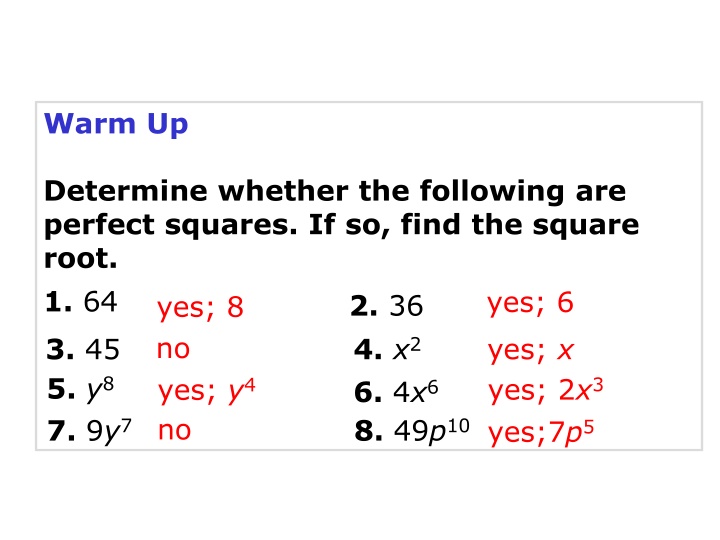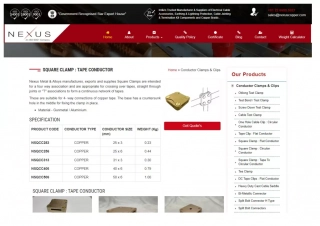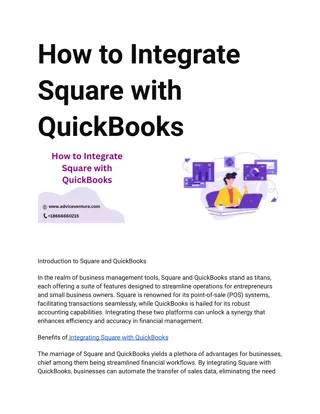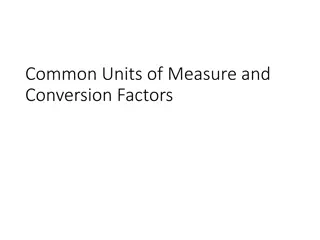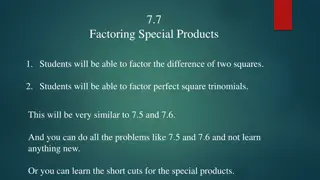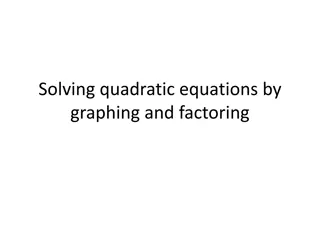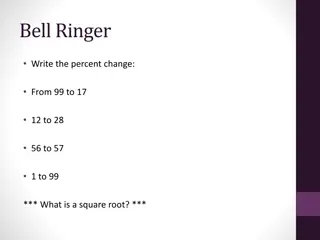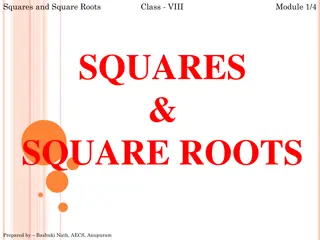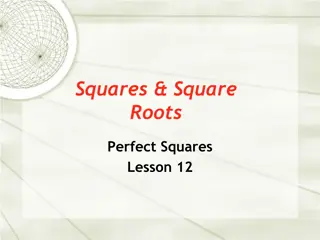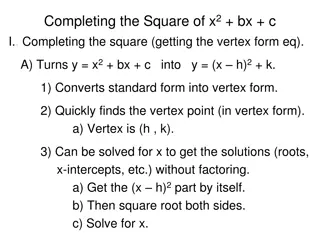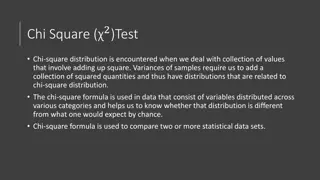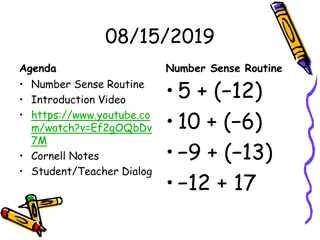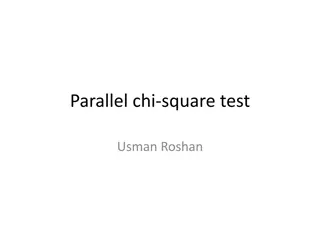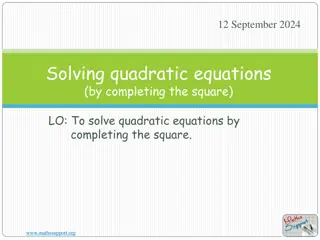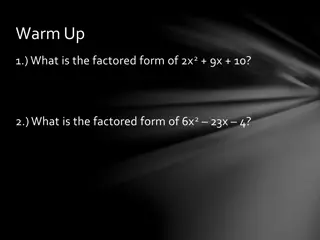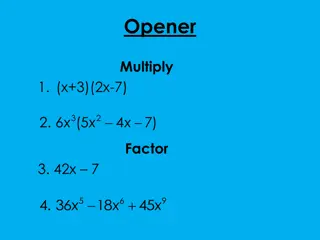Identifying and Factoring Perfect Square Trinomials
Learn how to determine whether a trinomial is a perfect square and how to factor it. Perfect square trinomials have specific characteristics with their terms, making them easy to recognize and factor. Examples and methods are provided to help you understand the concept better.
Download Presentation

Please find below an Image/Link to download the presentation.
The content on the website is provided AS IS for your information and personal use only. It may not be sold, licensed, or shared on other websites without obtaining consent from the author.If you encounter any issues during the download, it is possible that the publisher has removed the file from their server.
You are allowed to download the files provided on this website for personal or commercial use, subject to the condition that they are used lawfully. All files are the property of their respective owners.
The content on the website is provided AS IS for your information and personal use only. It may not be sold, licensed, or shared on other websites without obtaining consent from the author.
E N D
Presentation Transcript
Warm Up Determine whether the following are perfect squares. If so, find the square root. 1. 64 yes; y4 5. y8 7. 9y7 yes; 6 2. 36 4. x2 6. 4x6 8. 49p10 yes; 8 no 3. 45 yes; x yes; 2x3 no yes;7p5
Objectives Factor perfect-square trinomials. Factor the difference of two squares.
A trinomial is a perfect square if: The first and last terms are perfect squares. The middle term is two times one factor from the first term and one factor from the last term. 9x2 + 12x + 4 3x 3x 2(3x 2) 2 2
Example 1A: Recognizing and Factoring Perfect- Square Trinomials Determine whether each trinomial is a perfect square. If so, factor. If not explain. 9x2 15x + 64 9x2 15x + 64 3x 3x 2(3x 8) 8 8 2(3x 8) 15x. 9x2 15x + 64 is not a perfect-square trinomial because 15x 2(3x 8).
Example 1B: Recognizing and Factoring Perfect- Square Trinomials Determine whether each trinomial is a perfect square. If so, factor. If not explain. 81x2 + 90x + 25 81x2 + 90x + 25 9x 9x 2(9x 5) The trinomial is a perfect square. Factor. 5 5
Example 1B Continued Determine whether each trinomial is a perfect square. If so, factor. If not explain. Method 2 Use the rule. 81x2 + 90x + 25 a = 9x, b = 5 (9x)2 + 2(9x)(5) + 52 Write the trinomial as a2 + 2ab + b2. Write the trinomial as (a + b)2. (9x + 5)2
Example 1C: Recognizing and Factoring Perfect- Square Trinomials Determine whether each trinomial is a perfect square. If so, factor. If not explain. 36x2 10x + 14 36x2 10x + 14 The trinomial is not a perfect-square because 14 is not a perfect square. 36x2 10x + 14 is not a perfect-square trinomial.
Check It Out! Example 1a Determine whether each trinomial is a perfect square. If so, factor. If not explain. x2 + 4x + 4 x2 + 4x + 4 x x 2(x 2) 2 2 The trinomial is a perfect square. Factor.
Check It Out! Example 1a Continued Determine whether each trinomial is a perfect square. If so, factor. If not explain. Method 1 Factor. x2 + 4x + 4 Factors of 4 Sum (1 and 4) 5 (2 and 2) 4 (x + 2)(x + 2) = (x + 2)2
Check It Out! Example 1b Determine whether each trinomial is a perfect square. If so, factor. If not explain. x2 14x + 49 x2 14x + 49 x x 2(x 7) 7 7 The trinomial is a perfect square. Factor.
Check It Out! Example 1b Continued Determine whether each trinomial is a perfect square. If so, factor. If not explain. Method 2 Use the rule. x2 14x + 49 a = 1, b = 7 Write the trinomial as a2 2ab + b2. Write the trinomial as (a b)2. (x)2 2(x)(7) + 72 (x 7)2
Check It Out! Example 1c Determine whether each trinomial is a perfect square. If so, factor. If not explain. 9x2 6x + 4 9x2 6x +4 3x 3x 2(3x 2) 2 2 2(3x)(4) 6x 9x2 6x + 4 is not a perfect-square trinomial because 6x 2(3x 2)
Example 2: Problem-Solving Application A square piece of cloth must be cut to make a tablecloth. The area needed is (16x2 24x + 9) in2. The dimensions of the cloth are of the form cx d, where c and d are whole numbers. Find an expression for the perimeter of the cloth. Find the perimeter when x = 11 inches.
Example 2 Continued Understand the Problem 1 The answer will be an expression for the perimeter of the cloth and the value of the expression when x = 11. List the important information: The tablecloth is a square with area (16x2 24x + 9) in2. The side length of the tablecloth is in the form cx d, where c and d are whole numbers.
Example 2 Continued Make a Plan 2 The formula for the area of a square is area = (side)2. Factor 16x2 24x + 9 to find the side length of the tablecloth. Write a formula for the perimeter of the tablecloth, and evaluate the expression for x = 11.
Example 2 Continued Solve 3 a = 4x, b = 3 16x2 24x + 9 Write the trinomial as a2 2ab + b2. (4x)2 2(4x)(3) + 32 (4x 3)2 Write the trinomial as (a b)2. 16x2 24x + 9 = (4x 3)(4x 3) The side length of the tablecloth is (4x 3) in.
Example 2 Continued Write a formula for the perimeter of the tablecloth. Write the formula for the perimeter of a square. Substitute the side length for s. P = 4s = 4(4x 3) = 16x 12 Distribute 4. An expression for the perimeter of the tablecloth in inches is 16x 12.
Example 2 Continued Evaluate the expression when x = 11. P = 16x 12 = 16(11) 12 Substitute 11 for x. = 164 When x = 11 in. the perimeter of the tablecloth is 164 in.
Example 2 Continued Look Back For a square with a perimeter of 164, the side length is and the area is 412 = 1681 in2. 4 . Evaluate 16x2 24x + 9 for x = 11. 16(11)2 24(11) + 9 1936 264 + 9 1681
Check It Out! Example 2 What if ? A company produces square sheets of aluminum, each of which has an area of (9x2 + 6x + 1) m2. The side length of each sheet is in the form cx + d, where c and d are whole numbers. Find an expression in terms of x for the perimeter of a sheet. Find the perimeter when x = 3 m.
Check It Out! Example 2 Continued Understand the Problem 1 The answer will be an expression for the perimeter of a sheet and the value of the expression when x = 3. List the important information: A sheet is a square with area (9x2 + 6x + 1) m2. The side length of a sheet is in the form cx + d, where c and d are whole numbers.
Check It Out! Example 2 Continued Make a Plan 2 The formula for the area of a sheet is area = (side)2 Factor 9x2 + 6x + 1 to find the side length of a sheet. Write a formula for the perimeter of the sheet, and evaluate the expression for x = 3.
Check It Out! Example 2 Continued Solve 3 9x2 + 6x + 1 a = 3x, b = 1 (3x)2 + 2(3x)(1) + 12 Write the trinomial as a2 + 2ab + b2. (3x + 1)2 Write the trinomial as (a + b)2. 9x2 + 6x + 1 = (3x + 1)(3x + 1) The side length of a sheet is (3x + 1) m.
Check It Out! Example 2 Continued Write a formula for the perimeter of the aluminum sheet. Write the formula for the perimeter of a square. Substitute the side length for s. P = 4s = 4(3x + 1) = 12x + 4 Distribute 4. An expression for the perimeter of the sheet in meters is 12x + 4.
Check It Out! Example 2 Continued Evaluate the expression when x = 3. P = 12x + 4 = 12(3) + 4 Substitute 3 for x. = 40 When x = 3 m. the perimeter of the sheet is 40 m.
Check It Out! Example 2 Continued Look Back 4 For a square with a perimeter of 40, the side length is m and the area is 102 = 100 m2. Evaluate 9x2 + 6x + 1 for x = 3 9(3)2 + 6(3) + 1 81 + 18 + 1 100
In Chapter 7 you learned that the difference of two squares has the form a2 b2. The difference of two squares can be written as the product (a + b)(a b). You can use this pattern to factor some polynomials. A polynomial is a difference of two squares if: There are two terms, one subtracted from the other. Both terms are perfect squares. 4x2 9 2x 2x 3 3
Reading Math Recognize a difference of two squares: the coefficients of variable terms are perfect squares, powers on variable terms are even, and constants are perfect squares.
Example 3A: Recognizing and Factoring the Difference of Two Squares Determine whether each binomial is a difference of two squares. If so, factor. If not, explain. 3p2 9q4 3p2 9q4 3q2 3q2 3p2 is not a perfect square. 3p2 9q4 is not the difference of two squares because 3p2 is not a perfect square.
Example 3B: Recognizing and Factoring the Difference of Two Squares Determine whether each binomial is a difference of two squares. If so, factor. If not, explain. 100x2 4y2 100x2 4y2 The polynomial is a difference of two squares. 10x 10x (10x)2 (2y)2 (10x + 2y)(10x 2y) 2y 2y a = 10x, b = 2y Write the polynomial as (a + b)(a b). 100x2 4y2 = (10x + 2y)(10x 2y)
Example 3C: Recognizing and Factoring the Difference of Two Squares Determine whether each binomial is a difference of two squares. If so, factor. If not, explain. x4 25y6 x4 25y6 The polynomial is a difference of two squares. x2 x2 5y3 5y3 (x2)2 (5y3)2 a = x2, b = 5y3 Write the polynomial as (a + b)(a b). (x2 + 5y3)(x2 5y3) x4 25y6 = (x2 + 5y3)(x2 5y3)
Check It Out! Example 3a Determine whether each binomial is a difference of two squares. If so, factor. If not, explain. 1 4x2 1 4x2 The polynomial is a difference of two squares. 1 1 2x 2x (1) (2x)2 (1 + 2x)(1 2x) a = 1, b = 2x Write the polynomial as (a + b)(a b). 1 4x2 = (1+ 2x)(1 2x)
Check It Out! Example 3b Determine whether each binomial is a difference of two squares. If so, factor. If not, explain. p8 49q6 p8 49q6 The polynomial is a difference of two squares. p4 p4 7q3 7q3 (p4)2 (7q3)2 (p4 + 7q3)(p4 7q3) a = p4, b = 7q3 Write the polynomial as (a + b)(a b). p8 49q6 = (p4 + 7q3)(p4 7q3)
Check It Out! Example 3c Determine whether each binomial is a difference of two squares. If so, factor. If not, explain. 16x2 4y5 16x2 4y5 4y5 is not a perfect square. 4x 4x 16x2 4y5 is not the difference of two squares because 4y5 is not a perfect square.
Lesson Quiz: Part I Determine whether each trinomial is a perfect square. If so factor. If not, explain. Not a perfect-square trinomial because 40x 2(8x 5). 1. 64x2 40x + 25 2. 121x2 44x + 4 (11x 2)2 3. 49x2 + 140x + 100 (7x2 + 10)2 4. A fence will be built around a garden with an area of (49x2 + 56x + 16) ft2. The dimensions of the garden are cx + d, where c and d are whole numbers. Find an expression for the perimeter when x = 5. P = 28x + 16; 156 ft
Lesson Quiz: Part II Determine whether the binomial is a difference of two squares. If so, factor. If not, explain. (3x + 12y2)(3x 12y2) Not a difference of two squares; 30x2 is not a perfect square 5. 9x2 144y4 6. 30x2 64y2 7. 121x2 4y8 (11x + 2y4)(11x 2y4)
